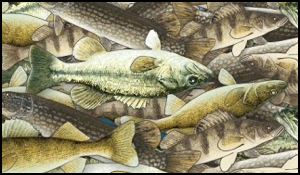
The following movies were created to supplement the content covered in Fish Lake. Math videos predominantly focus on fractions, with four additional videos on problem-solving strategies and and a bonus video on division terms. The cultural content videos focus on Ojibwe (Chippewa) culture. You can also visit our 7 Generation Games YouTube channel.
Fish Lake Math Videos
Understanding fractions – What is a fraction, anyway?
- Understanding fractions – explains how Native American children could use fractions to keep track of time
- What is a half? – An explanation of what is a half, using multiple examples from travel to shapes.
- Is one-half fair? – How many times have you heard kids insist something wasn’t fair? This video uses fractions and the concept of one-half to determine if two people are doing the their fair share of the work, getting their fair share of a pile of blankets.
- What’s a numerator? What’s a denominator? – Parts of fraction explained with a pile of fish.
Equivalent Fractions
Introducing Equivalent Fractions
- Meeting in the Middle – This video extends the idea of one-half and introduces equivalent fractions, with examples from traveling between two camps.
- When is a fraction the same as 1? This video expands on the idea of equivalent fractions with practical examples and then introduces the concept of equivalence regardless of the size of the numbers or what is being divided into fractions. A version of this video is also available in Spanish: Cuando es la fracción igual a uno?
Converting to an equivalent fraction
- Fractions and Fishing – How do we know if the fishing is getting worse? We convert the fractions of fish over a foot long to be equivalent
- How to Compare Fractions with UnLike Denominators How do you compare fractions with different denominators? One way is to visualize, to draw the fraction, but that isn’t always easy. You can also change one (or more) of the fractions so they have the same denominator, then, presto, the one with the larger numerator is bigger.
Working with like fractions (same denominator)
Comparing Fractions with Like Denominators
- How to Compare Like Fractions – What are like fractions? How do we compare like fractions?
Adding Like Fractions
- Comparing and adding fractions with like (common) denominators – What’s a denominator? What’s a numerator? How do you know if one fraction is larger? Why does that matter? Watch this video to answer these questions.
- Adding Like Fractions – Like fractions have the same (common) denominator, which makes them easy to add, as shown in the examples in this video.
Mixed Fractions
- Explaining Mixed Fractions – What exactly is a mixed fraction? What do we mean by changing from mixed form to fraction form? Sometimes, it’s helpful to have these things explained to you step by step.
- Mixed Form to Fraction Form: Examples – When learning how to convert fractions from mixed form to fraction form, it can help to have a lot of examples. We’re here to work through examples with you, whether it’s on a number line, shapes, or eating fish.
Fractions on a Number Line
- Number lines and Finding Your Way – Review of number lines and an introduction to number lines using fractions and how to use these. If you’ve ever wondered how fractions and number lines can be useful, this video is for you.
- Using a Number line in Fraction Problems – How do you know where you are going? If you were going somewhere, you might type the name of the place or address into the computer to get a map. You might call someone on the phone. What if there were no phones and no computers? Watch this video to find out how travelers could use a real-life number line and fractions to find their way from one spot to another.
Problem-Solving Strategies
- Write Out the Numbers and What They Represent with Super Amy and Vin-credible
- Problem Solving Tip: Throw it out A version of this video is also available in Spanish: Quita lo que no necesitas.
- One Way To Solve a Problem is to Build a Model A version of this video is also available in Spanish: Construyendo un Modelo
Division Terms – If you can’t remember which is the dividend and which is the divisor. A version of this video is also available in Spanish: Términos de división.
Fish Lake Culture Videos
- Rabbit stew – how snaring rabbits helped the Turtle Mountain Ojibwe survive
- Ways to fish – the Ojibwe fishing techniques. A version of this video is also available in Spanish: Maneras Tradicionales de Pescar.
